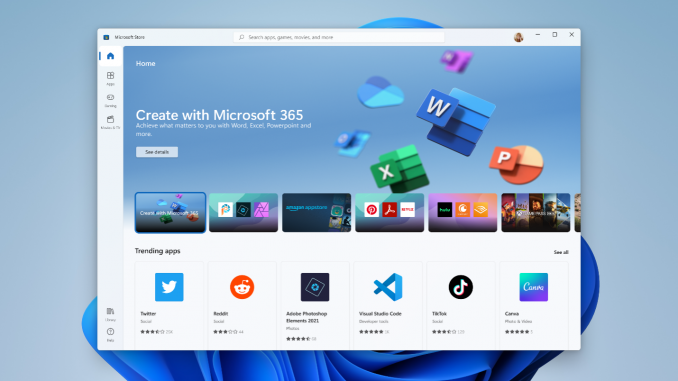
Developing for Windows 11

Developing for Windows 11
Windows 11 was built to unlock the full power of the PC. This new operating system empowers you to deliver new and innovative apps, grow your business how you choose, and makes developing on Windows easier by allowing you to use the tools and frameworks you already use and know. Windows 11 is our most open platform yet and it gives you the ability to build and run the widest range of apps. We can’t wait to see what you build for your users to learn, create, and play. Here are the key updates you should know about:
- The new Microsoft Store;
- Advancements and updates for web and native development; and
- Updates to our Fluent design system
Grow your business with the new Microsoft Store
Image 1: The new Microsoft Store
The new Microsoft Store is more open and allows you and your customers to be more productive and easily find the best apps. The new Store focuses on openness, fairness, and innovation. This means more apps are available in the store without having to update business models or re-write apps; more apps are discoverable due to updated policies that allow standalone digital storefront apps to be found via search, and to encourage innovation we’re enabling you to bring your own browser engine so you can innovate how you chose. This is the start of our journey, and we hope you’ll continue to engage with us so we can continue to provide access to broader markets and opportunities.
Streamline your Web and native app development
Windows 11 was built with developers in mind – to create a platform that provides a seamless development experience no matter what app you are building. We continue to learn from our past and understand vision, innovation, and creativity can truly thrive when tools, features, and experiences are easy to use. That’s why we’ve taken steps to make developing on Windows easier.

Image 2: Microsoft Edge DevTools in a variety of color themes.
WebView2 is now part of the operating system for everyone. We’ve significantly improved performance and reduced the disk footprint, memory usage, and launch time of your WebView2 apps by hard linking with the Edge browser. And, for those of you building Progressive Web Apps, we’ve improved the desktop integration and user experience with new standards-based and experimental capabilities. You can now integrate your apps more seamlessly with the desktop by customizing the titlebar, registering as a default handler for links or protocols, and even handling files on the user’s filesystem. Of course, you can continue to use offerings like Windows Terminal and our Microsoft Edge DevTools themes to match the visual experience found throughout Windows 11.
The Windows App SDK and WinUI 3 represent the latest in native app development for Windows 11, and they empower you to build the most productive desktop apps in the world. The Windows App SDK 1.0 Preview 1 brings many new developments, including support for the MSAL library, AppInstance APIs for handling and redirecting activation, AppWindow APIs for managing your window regardless of what UI stack you’re using, performance and reliability improvements, and much more.
With Windows 11, we’ve made it easier for you to run your apps on Windows on ARM. You can run your unmodified x64 apps using emulation, or you can compile your apps natively for ARM64 for the best possible performance on these devices. Windows 11 on ARM also introduces the new ARM64 Emulation Compatible ABI which enables you to build apps that can contain or load both ARM64EC and x64 code, allowing you to incrementally migrate existing x64 apps to run natively on ARM64 over time.
Refresh your apps and experiences
Windows 11 is the first major redesign of Windows and we did it to bring the operating system closer to the ecosystem of products that are being created at Microsoft.

Image 3: Microsoft Fluent Design showing examples of rounded geometry, acrylic, mica, and our new typography and iconography.
Windows 11 feels more modern and beautiful. The subtle change of rounding our geometry across all of the UI surfaces makes Windows feel more approachable and your apps easier to scan, which helps your customers stay more engaged. Some of the visual updates in Windows 11 will be inherited by apps with no additional code changes, but to benefit from all these visual updates, some work will be required. We recommend you focus on three areas:
- Use UI with rounded geometry. This can be applied to both the non-client area and to the client area of the app.
- Apply the refreshed color palette and materials. The new color palette is applied automatically to our latest WinUI controls (WinUI 2.6 or greater required), apps that use acrylic can switch to the latest brush, and our new material Mica lets the wallpaper image shine through the frame of your app.
- Update to our typography and iconography. Windows 11 delivers two new system icons. To incorporate the evolved Segoe UI, you need WinUI 2.6 (or greater), and your controls will automatically inherit the latest font family. To use the Segoe Variable UI, you should point to “Segoe UI Variable” in any instance that references “Segoe UI”.
Windows 11 is the next generation of Windows, and the entire experience was reimagined with you and your users in mind. We wanted a platform that would feel like home – centered on you but with more openness and security. We can’t wait to see what you build.
Source: Developing for Windows 11







Leave a Reply